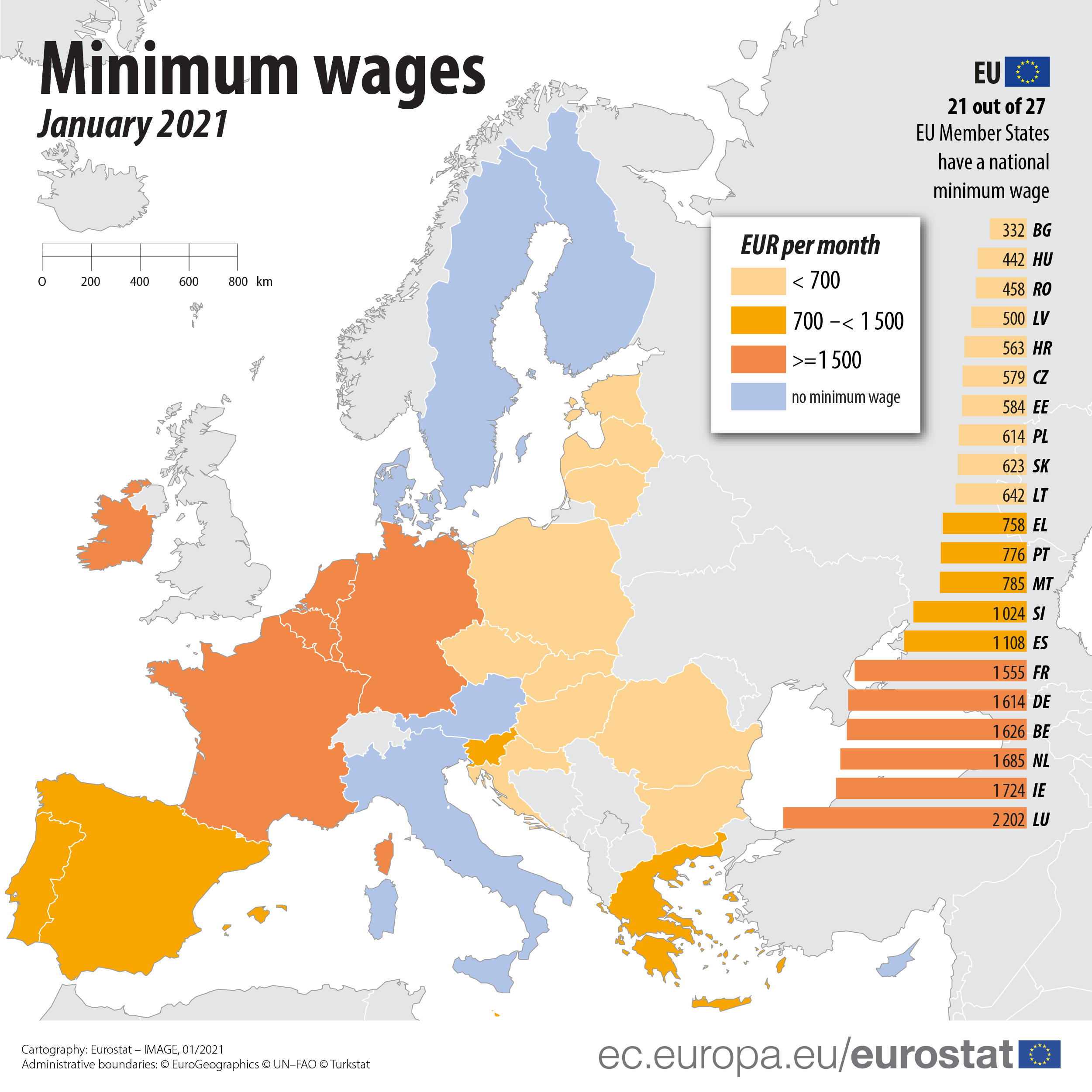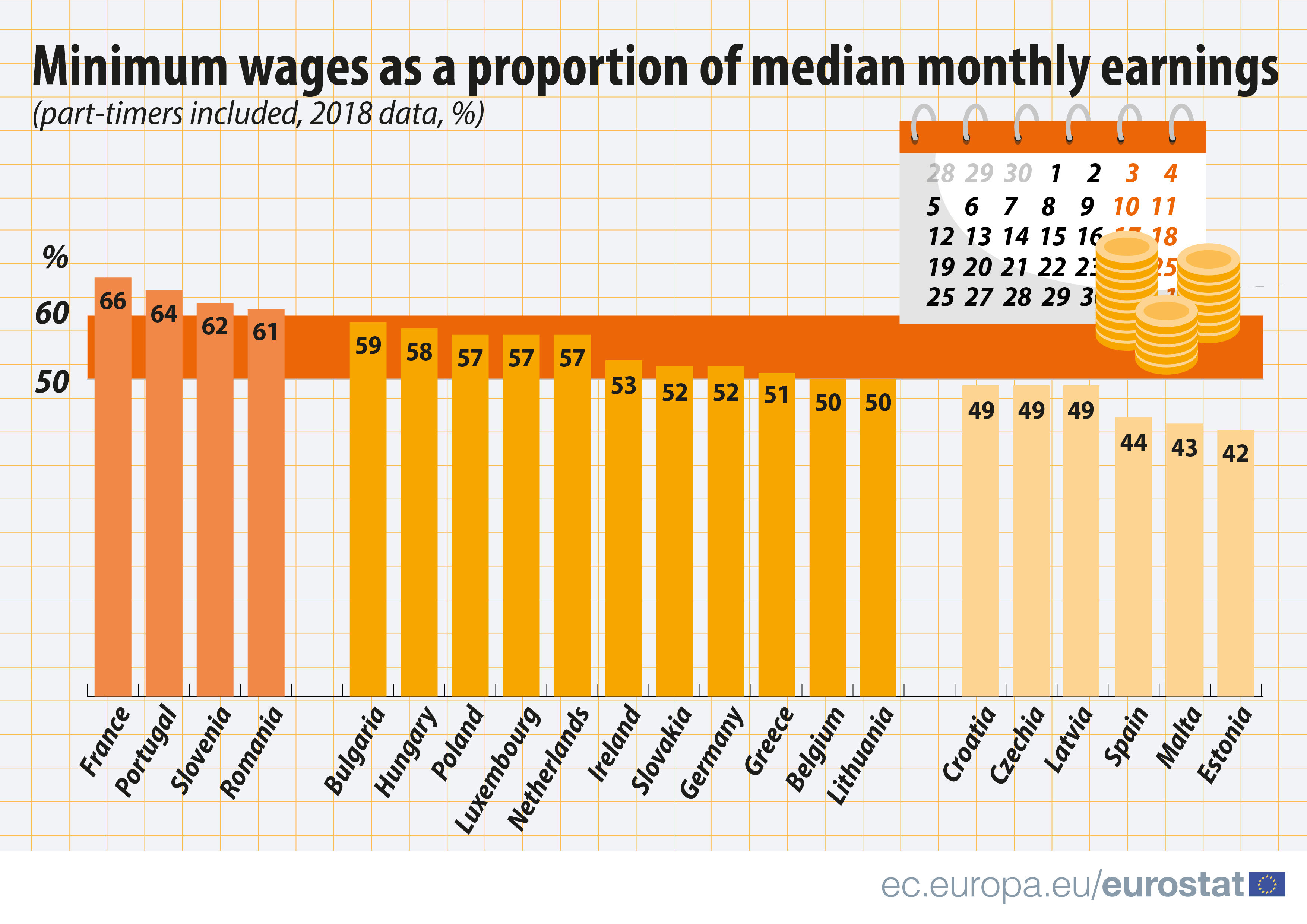As of 1 January 2021, 21 out of the 27 Member States of the EU have national minimum wages: only Denmark, Italy, Cyprus, Austria, Finland and Sweden do not.
Monthly minimum wages generally below €700 in east and above €1 500 in northwest of the EU
The 21 EU Member States that have national minimum wages can be divided into three main groups based on their levels in euro.
In January 2021, ten Member States, located in the east of the EU, had minimum wages* below €700 per month: Bulgaria (€332), Hungary (€442), Romania (€458), Latvia (€500), Croatia (€563), Czechia (€579), Estonia (€584), Poland (€614), Slovakia (€623) and Lithuania (€642).
In five other Member States, located mainly in the south of the EU, minimum wages ranged between €700 and just over €1 100 per month: Greece (€758), Portugal (€776), Malta (€785), Slovenia (€1 024) and Spain (€1 108).
In the remaining six Member States, all located in the west and north of the EU, minimum wages were above €1 500 per month: France (€1 555), Germany (€1 614), Belgium (€1 626), the Netherlands (€1 685), Ireland (€1 724) and Luxembourg (€2 202).
For comparison, the federal minimum wage in the United States was €1 024 in January 2021.
The source dataset is available here.
Smaller gaps in minimum wages once price level differences are eliminated
Across the 21 Member States concerned, the highest minimum wage in the EU was 6.6 times higher than the lowest.
However, the disparities in minimum wages across the EU Member States are considerably smaller once price level differences are taken into account: when expressed in purchasing power standard (PPS), minimum wages in Member States with lower price levels become relatively higher and relatively lower in Member States with higher price levels.
By eliminating price differences, minimum wages ranged from 623 PPS per month in Bulgaria to 1 668 PPS in Luxembourg, meaning that the highest minimum wage was 2.7 times higher than the lowest.
Minimum wages above 60% of median gross monthly earnings in France, Portugal, Slovenia and Romania
Minimum wages may also be measured in relative terms, i.e. as proportion of the median earnings**. Based on the last available data from the four-yearly Structure of Earnings Survey, in 2018 minimum wages represented over 60% of the median gross monthly earnings in only four Member States: France (66%), Portugal (64%), Slovenia (62%) and Romania (61%). By contrast, minimum wages were less than half of the median earnings in six Member States: Croatia, Czechia and Latvia (all 49%), Spain (44%), Malta (43%) and Estonia (42%).
Further information is provided in the Statistics Explained article Minimum wage statistics.
* Before any tax and social security contributions are deducted
** Data refer to the gross monthly earnings covering wages and salaries earned by full-time and part-time (in full-time equivalent) employees in the reference month (October 2018 in most countries). They exclude overtime pay and other extra payments and are calculated before any tax and social security contributions are deducted.
Eurostat provides national minimum wages at monthly rates. When the minimum wage is paid for more than 12 months per year (as in Greece, Spain and Portugal, where it is paid for 14 months a year), data have been adjusted to take these payments into account.
Note: The European Union (EU) includes 27 EU Member States. The United Kingdom left the European Union on 31 January 2020. Further information is published here.
To contact us, please visit our User Support page.
For press queries, please contact our Media Support.



